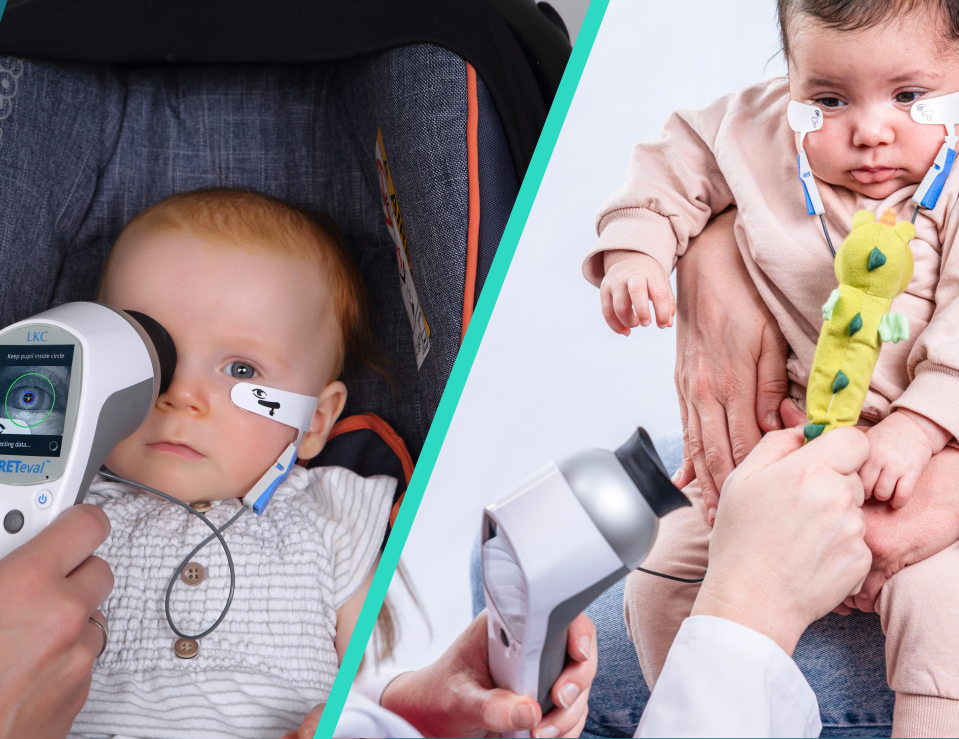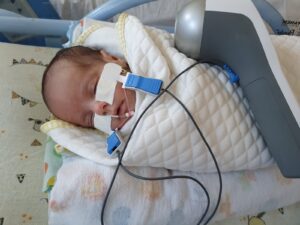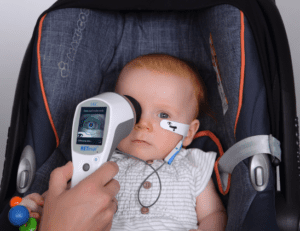The Use of RETeval ERG/VEP in Pediatric Ophthalmology
Interview with Dr. Ayelén Ginesta and Dr. Maria Ana Martínez

Interviewer:
Welcome, Dr. Ginesta and Dr. Martínez! Thank you for joining us. Dr. Ginesta, could you start by introducing yourself?
Dr. Ayelén Ginesta:
I’m Ayelén Ginesta. I work at the Eye and Ear Institute, in Resistencia, Chaco, Argentina. I studied medicine at the National University of the Northeast (UNNE), where I currently teach, and completed my postgraduate degree at the Catholic University of Cordoba (UCC) on Advances in Pediatric Ophthalmology and Strabismus. I’m excited to share my experience with electroretinography (ERG), and how we’re able to use the RETeval device in clinical practice, especially in cases with young patients.
Interviewer:
That sounds fascinating. Could you tell us more about the role of electroretinography in pediatric cases?
Dr. Ayelén Ginesta:
Certainly. Electroretinography, or ERG, measures the retina’s electrical response to light. It tracks this response from the photoreceptors through to the optic nerve, providing a functional analysis of the entire visual pathway. This is critical in pediatric cases for diagnosing and understanding conditions that may not be visibly evident. We can use ERG to identify inherited retinal diseases, toxicities affecting the retina, and other systemic conditions that manifest in the eye.
Interviewer:
Electrophysiology tests can be challenging. How does RETeval help make ERG accessible, especially for younger patients?
Dr. Ayelén Ginesta:
Traditional electrophysiological devices are often heavy, require significant patient cooperation, and can be expensive, which limits their availability, especially in Latin America. RETeval, however, simplifies the process. It doesn’t need corneal contact electrodes, instead using adhesive Sensor Strips that are particularly well-suited for pediatric patients, including infants. I even call them “stickers” to make it fun for kids. The setup is quick and minimally invasive, which makes it less intimidating and more practical for children.
Dr. María Ana Martínez:
And I would add that RETeval’s portability means we can conduct exams outside the traditional clinical setting. In my practice, we easily bring the device to surgical settings without any logistic burden, and we can use it in situations with children with special needs, like autism or cerebral palsy. This accessibility is invaluable when we’re working with children who may find clinic visits stressful.
Interviewer:
Dr. Martínez, could you share more about your background and how RETeval is used in your work with retinopathy of prematurity (ROP) and other conditions?
Dr. María Ana Martínez:
I’m a specialist in pediatric retinal conditions. I studied Medicine at the Autonomous University of the State of Mexico and Ophthalmology at the Central Military Hospital. I trained in pediatric retina at top institutions, including NewYork-Presbyterian Hospital and Children’s Hospital Los Angeles. I currently work at the Association to Prevent Blindness in Mexico (APEC). I have my own clinic in Toluca, where I specifically treat ROP.
This condition has a significantly higher prevalence in Latin America than in more developed regions, because there are less available resources to manage the disease. Therefore, many children develop ROP stage 5, which not only causes blindness, but also bears the potential side effects of severe pain, abnormal circadian rhythm, cataracts, glaucoma, and more. We specialize in the surgical management of these cases that are quite often complicated by the presence of autism or cerebral palsy. With the RETeval, we can assess the visual function and light perception that could be preserved with surgery, helping us decide on interventions in such cases.

Premature baby with small-sized electrodes: Tiras de sensor
Interviewer:
It sounds like both of you have used RETeval with diverse cases. Could you share any specific examples where it proved to be particularly useful?
Dr. Ayelén Ginesta:
I recently saw an 8-year-old with decreased acuity and altered color vision, which led us to suspect cone-rod dystrophy. Using RETeval’s full-field ERG, we confirmed abnormalities in both rod and cone functions, guiding us toward the diagnosis. The device’s ability to deliver fast, detailed data allowed us to start a tailored management plan immediately.
Dr. María Ana Martínez:
I would love to share two examples of children I was recently managing. One is a three-year-old boy who had aggressive ROP requiring laser and anti-VEGF. We performed a VEP with the RETeval with that boy, finding reasonably good results. This finding was in contrast to a 1 1/2 year-old child with previous stage 4 ROP in both eyes. After performing the VEP with this child, we saw no response for one eye, but a reasonably good result in the other eye. This child then had surgery for the better-seeing eye to maintain as much vision as possible.
RETeval ERG/VEP device in pediatric ophthalmology
Learn more about the use of RETeval with pediatric patients
Interviewer:
RETeval clearly has clinical advantages. Beyond the easy process of diagnosing and clinical decision-making, are there other benefits of using the device with pediatric patients?
Dr. Ayelén Ginesta:
With RETeval, we can perform ERG in a way that is engaging and non-intimidating for young children. The device works even with the child sitting on a parent’s lap, which is invaluable for children who need reassurance. And because it’s such a quick test, we often complete it before the child even realizes they’re being examined.

ERG examination in a baby carrier using a RETeval
Dr. María Ana Martínez:
For me, the device’s non-restrictive design means we can work anywhere without logistic challenges, even with children who may have additional neurological conditions. We’ll just pack the device and go into the specific surgery room, or stay within the exam room and not have to move into a special testing location. In addition, it is the objectivity of the assessment that is truly valuable. For example, many of these children are unable to communicate whether they can see light or not, yet light perception can be important for circadian rhythm regulation, which supports hormone and growth regulation. RETeval lets us assess this perception and understand how the eye and brain are working together, even when the child can’t communicate.
Interviewer:
Given RETeval’s utility and flexibility, what advice would you offer other pediatric ophthalmologists who may be considering it?
Dr. Ayelén Ginesta:
I would say, don’t hesitate to explore it! This device makes complex retinal assessments accessible, even for children. And because it’s fully portable and battery-operated, it’s especially valuable in regions where access to specialized ophthalmology services might be limited.
Dr. María Ana Martínez:
Yes, and the device allows us to understand the function in cases that otherwise might go unnoticed or would be impossible to really assess. I urge my colleagues to consider adding an objective tool for children that may have many various challenges, such as neck constraints or immobility or neurologic deficits. Adding the RETeval to our portfolio has provided us with a high-quality and objective tool, not only for diagnostics, but also for pre-operative decisions as well as treatment follow-up.
Interviewer:
Thank you both for this insightful conversation and for sharing the ways RETeval is advancing pediatric ophthalmology.

Dr. Ayelén Ginesta
The Eye and Ear Institute in Resistencia, Chaco, Argentina
I am Ayelén Ginesta, a physician specializing in Ophthalmology and Pediatric Ophthalmology. I work at the Eye and Ear Institute in Resistencia, Chaco, Argentina. I studied medicine at the National University of the Northeast (UNNE), where I currently teach.
I completed my specialist postgraduate degree at the Catholic University of Córdoba (UCC), where I am currently pursuing an advanced update postgraduate course in Pediatric Ophthalmology and Strabismus.

Dr. Maria Ana Martínez
Star Medica Hip Hospital, México
María Ana Martínez-Castellanos is an accomplished ophthalmologist specializing in Retinopathy of Prematurity (ROP) and Medical and Surgical Retina. She studied Medicine at the Autonomous University of the State of Mexico and Ophthalmology at the Central Military Hospital. She further trained in Pediatric Retina at top institutions, including New York Presbyterian Hospital and the Children’s Hospital of Los Angeles. Currently, she works at the Association to Prevent Blindness in Mexico (APEC) and has established her own clinic in Toluca, equipped for premature infants. She is also involved in opening a pediatric retina medical-surgical area at APEC.
María Ana, influenced by mentors like her father and Hugo Quiroz, is dedicated to advancing ophthalmology in Latin America through global integration and telemedicine. Internationally recognized for her research on ROP, she remains committed to improving healthcare in Mexico. Passionate about golf, art, and collecting illustrated books, she is a multifaceted professional dedicated to both her career and personal interests.
